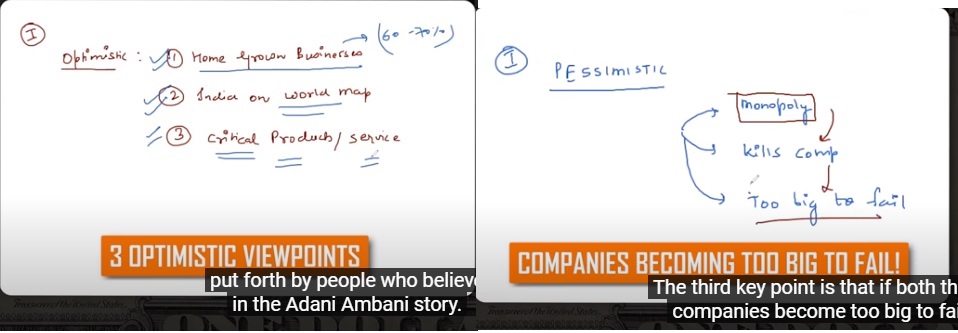By insisting on non-violence, Bapu extinguished the raging fire of communal violence in many parts of India but he himself fell victim to the bullets of an assassin. But how did it affect India for the next fifty years?
बापू के आख़री कुछ साल | Mahatma Gandhi’s last years | तुषार गांधी https://www.youtube.com/watch?v=MJGcXsochYQ Citizens for Justice and Peace Oct 1, 2023
The last four years of his life proved to be the toughest test of Mahatma Gandhi's principle of non-violence. From Direct Action Day to Partition, when the whole of India was burning in the fire of national hatred and violence, and the leaders of Congress and Muslim League were baking their bread, Bapu alone, risking his life, traveled from 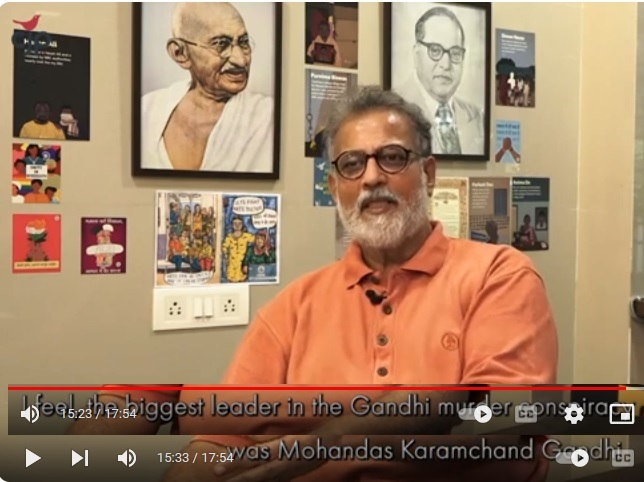 Delhi to Noakhali, Bihar. From Calcutta to Calcutta, he kept fighting for the unity of India, taking support of the stick of non-violence. History is witness to the fact that through this effort he was successful in maintaining peace in the eastern parts of the country, but he had to fall victim to Nathuram Godse's bullet. In his books and also in this interview, Bapu's great-grandson Tushar Gandhi says about his last years that because of this valiant effort, especially as a result of his martyrdom, the wind of national hatred blew in this country for about fifty years, if at all it did not last. Didn't get it.
Delhi to Noakhali, Bihar. From Calcutta to Calcutta, he kept fighting for the unity of India, taking support of the stick of non-violence. History is witness to the fact that through this effort he was successful in maintaining peace in the eastern parts of the country, but he had to fall victim to Nathuram Godse's bullet. In his books and also in this interview, Bapu's great-grandson Tushar Gandhi says about his last years that because of this valiant effort, especially as a result of his martyrdom, the wind of national hatred blew in this country for about fifty years, if at all it did not last. Didn't get it.
Because times are changing now, and a new era of violence seems to be beginning, it has become necessary to remember those last few years of Bapu.
Citizens for Justice and Peace has been working for national unity in India for the last thirty years. We are Gandhiji's followers in this fight. This special video series with Tushar Gandhi is just an attempt to convey Gandhiji's thoughts to the public in the era of fake news and violence.
 https://youtu.be/tXFQ0fx6PL0 On the Investigation- Discussion on Screening of Who killed Gandhi -
https://youtu.be/tXFQ0fx6PL0 On the Investigation- Discussion on Screening of Who killed Gandhi -
https://youtu.be/0uUwmjdxMcc On the Historical Context-
https://youtu.be/4NI5flM76Xc Why no public Screening of the Film Who killed Gandhi in India
https://youtu.be/A35gQbrGhf8 On the Hindutva Narrative
Q & A after a recent screening of the film..https://www.youtube.com/watch?v=GB4i1G6OgYE
Caste, the cancer afflicting Sanatan Dharma https://www.allindiansmatter.in/caste-the-cancer-afflicting-sanatan-dharma/ But when Udhayanidhi Stalin points out how Sanatan Dharma has been corrupted, all of us are annoyed. How dare he call for its eradication? Ambedkar called for the ‘Annihilation of Caste’. Bapu too, in his own gentle manner, called for it. None of them called for a genocide of Hindus or the upper castes. Let’s not allow sanghis and bhakts fool us into believing it.
All reformers warned about the danger institutionalised oppression poses to the existence of Sanatan Dharma but we have not heeded the warnings. What is being sought to be eradicated is Varna Vyavastha and the prejudices it instils in all of us and the oppression which is its very creed. That cancer afflicting Sanatan Dharma must be eradicated. Otherwise, one day, it will ensure the demise of Sanatan Dharma itself.
On the Hindutva Narrative - Discussion after screening of "who killed Gandhi"
https://www.youtube.com/watch?v=A35gQbrGhf8
3 सप्टेंबर 2023 रोजीवाढवण समुद्रकिनारीभव्य एल्गार मोर्चाचे आयोजन .. justice was trampled upon by allowing the expansion of the port to JNPT on certain conditions. A grand Elgar march has been organized on September 3, 2023 at the beach of Wadhwan to warn the government of the demand to cancel theWadhwan port forever, and to decide the direction of the further agitation, expressing outrage against this authority.
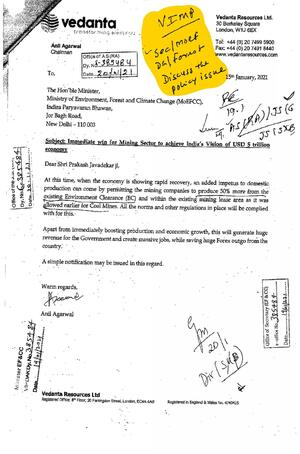 Inside Indian Energy and Mining Giant Vedanta's Campaign to Weaken Key Environmental Regulations by Akshay Deshmane 31 August 2023
Inside Indian Energy and Mining Giant Vedanta's Campaign to Weaken Key Environmental Regulations by Akshay Deshmane 31 August 2023
https://www.occrp.org/en/investigations/inside-indian-energy-and-mining-giant-vedantas-campaign-to-weaken-key-environmental-regulations .
Report shows how mining and oil giant Vedanta successfully ran a covert lobbying campaign during the pandemic to weaken India's key environmental regulations. The Narendra Modi-led government approved the changes without public consultation and implemented them using what experts say are illegal methods.
In early 2022, after a series of closed door meetings, India’s environment ministry loosened regulations to allow mining companies to increase production by up to 50 percent without needing to hold public hearings, which many in the industry considered the most onerous requirement of the environmental clearance process.
Though the head of a major industry lobby group and India’s mining secretary also pressed for the rules to be loosened, internal documents and government sources suggest Vedanta’s lobbying was key. The environment ministry then changed the regulations by publishing an office memo — meant to be used for inter-office communication — on its website.
The year before Agarwal wrote to Modi, one of the company’s subsidiaries, Cairn Oil & Gas, also started lobbying to scrap public hearings for oil exploration projects. As with mining, the government quietly amended the law with no public consultation. Since then, at least six of Cairn’s oil projects in the northern deserts of Rajasthan have been greenlit for development...
Indian authorities blocked the websites of activist groups that were campaigning on environmental issues, including one that was fighting against a major new piece of environmental legislation.
In April, the Central Bureau of Investigation filed charges against environmental lawyer Ritwick Dutta, claiming he uses foreign funds to “take down” coal projects. Legal watchdog Article 14 cited experts describing the case as “replete with factual errors and misrepresentations” and saying it would “have a chilling effect on environmental litigation in India.”
This year, the Centre for Policy Research, a think tank, had its license to receive foreign funding suspended and tax authorities started looking into their records for alleged violations, reportedly due to its “involvement” with environmental causes.
Activities, events, articles, links among other things to be used for inspiration and a resource.
We perceive education as a natural process through engaging with and forming relationships with the living and non living, exploring ourselves through the arts and silence, in order to discover the inner self and beyond; our non separateness, the Consciousness Connection that make us One.
https://hrutcollage.wordpress.com/
Homeschooling or Whole Being Living | Urmila Samson https://www.youtube.com/watch?v=oCwAz1b6PZ8 TEDx Talks Jul 10, 2018
There is thinking out of the box and then there is learning out of the box. Urmila Samson is a person who is a proponent of the latter. Hailing from Pune, she home schooled or as she calls it "unschooled" her children while being the co-founder of Swashikshan-Association of Indian Homeschoolers. The pedagogy revoles around picking up cues from the child about their inclination and providing them the tools to develop those skills.
It worked out when her daughter got into Eurythmy in London based solely on the merit of her essay, without having to give her A-level exams. With the community of parents choosing to home school their children growing, it is an honour to have Pune's MVP to tackle the orthodoxy of our current education system. Urmila Samson is one of the most distinguished homeshooling mothers in India. She, with her husband John, have radical ideas about learning and have opted to un-school their three children aged 25 years, 21 years and 18 years, who have never been to school. Her favourite definition of education is engaging with everything – living and non-living. Urmila is the co-founder of Swashikshan-Association of Indian Homeschoolers and has always been connected with people to guide them on right information and resources, with a burning desire to change the current scenario of the education system.
In his recent article, titled
There’s a case for ‘we the people’ to embrace a new Constitution https://www.livemint.com/opinion/online-views/theres-a-case-for-we-the-people-to-embrace-a-new-constitution-11692021963182.html 14 Aug 2023 Bibek Debroy, highlighted the Hindu right's real problem with the Constitution.. ...the three recent Bills on criminal justice are examples. Partly, one reclaims our forgotten heritage; Sengol is a metaphor for that.
what about the Seventh Schedule and local bodies? If development is correlated with urbanization, why have we set up these rural-urban silos, exemplified in the 73rd and 74th amendments?
what’s the Supreme Court’s role... There are articles in the Constitution that impede executive efficiency, at least for all-India services. What about electoral reform and the Rajya Sabha’s role?
..Should one subject specific geographical areas to special laws, thereby never mainstreaming them? (This isn’t only about Article 370 as there are others.) If reforms are about markets and a refocused and reduced role for government, what sense do we make of the Directive Principles of State Policy?
All Those Demanding a New Constitution Are Fighting for a Less Equal India https://thewire.in/politics/all-those-demanding-a-new-constitution-are-fighting-for-a-less-equal-india Runyani .. the ideologues and leaders from the Hindu right have been asserting that this constitution is a colonial legacy, based on the Government of India Act of 1935 of the British and does not reflect ‘Indian values’
As the Constitution was implemented, the RSS mouthpiece rejected it and demanded the Manusmriti as the Constitution. An editorial in Organiser on Novemner 30, 1949 read: “But in our Constitution, there is no mention of the unique Constitutional development in Ancient Bharat. Manu’s laws were written long before Lycurgus of Sparata or Solon of Persia.
https://indianexpress.com/article/india/bibek-debroy-article-for-new-constitution-pm-panel-says-not-our-view-8897462/ “The recent article by Dr @bibekdebroy was in his personal capacity. In no way do they reflect the views of EAC-PM or the Government of India,” the EAC-PM posted Thursday evening. The EAC-PM is an independent body constituted to give advice on economic and related issues to the Government of India, specifically to the Prime Minister.

He transcended the political through aesthetics and politicised the symbolic. For a generation, he symbolised the spirit and politics of revolutionary change, primarily in Telangana, but his songs travelled well beyond.
Revolutionary balladeer Gaddar passed away on Sunday, August 6. He leaves behind a legacy that will last for a very long time and with it a number of questions that hold the promise of rethinking the processes of social transformation.
Gaddar rose to unprecedented fame in the 1990s, when he walked into the open from a life in the ‘underground’. He was part of the revolutionary movement that later came to be known as the Maoists. For a generation, he symbolised the spirit and politics of revolutionary change, primarily in Telangana, but his songs travelled well beyond. He was neither a trained singer nor a writer. He spontaneously reflected the rebellious spirit of Telangana. He symbolised the energy of the time of revolutionary politics and was its greatest makings. His songs were not just an art but a phenomenon. His songs were listened to and appreciated cutting across classes. He had a unique reach into the drawing rooms and playing recorders of the rich and dominant castes.
09/08/2023
A Salute to Achyut Yagnik, the One-Man Storehouse of Knowledge on Gujarat https://thewire.in/society/a-salute-to-achyut-yagnik-the-one-man-storehouse-of-knowledge-on-gujarat
He was always “Achyut Bhai”, always available for a spot of conversation, or a dialogue if you preferred, or a declamation if you had the discipline of patience. Either way, it was always a rewarding encounter.
(SETU – Centre for Social Knowledge and Action) resembled an ashram in its bare austerity but suggested the ambience of a coffee house, where over many cups of syrupy tea – and the smoke of his never-extinguished cigarette – the visiting interlocutor could get tutored into the nuances of the latest developments, be it the Navnirman Movement, the anti-reservations riots of 1981, the 1985-86 communal flare-up, the anti-Narmada dam movement, the 1990-92 Ayodhya violence, or the horrible, horrible 2002 carnage.
Achyut Bhai himself personified the very idea of a robust civil society – keeping a firm distance from the wielders of power in Gandhinagar yet willing to engage with “authority” on behalf of the poor and the underprivileged. He was available to any NGO, any movement, any group wanting to correct this or that economic injustice in any part of Gujarat
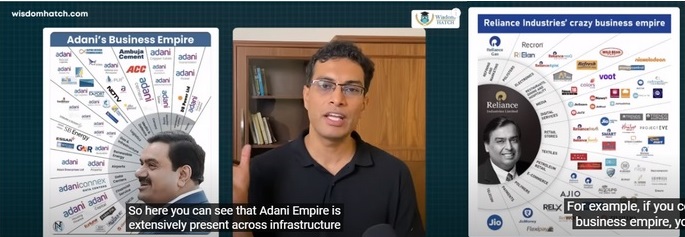
Analysing the Adani-Ambani BUSINESS EMPIRE (and its impact on you) | The GREAT Indian MONOPOLIES https://www.youtube.com/watch?v=OPGgKbSORb4 Akshat Shrivastava Jul 26, 2023
2 companies that have become household names in India. Are they going to end up owning the country?
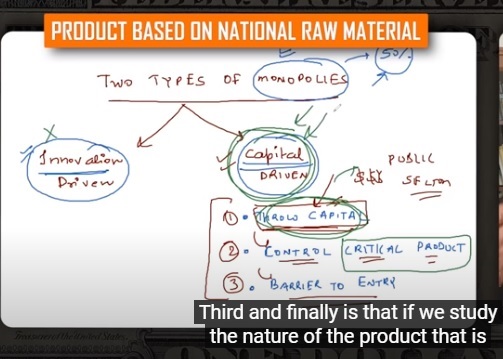 Solution suggested by Akshat Srivastava.
Solution suggested by Akshat Srivastava.
Duoploistic Bussiness.
Learn about stock investing, and invest wisely.
Support small business, in your investment aswell as in your consumption.
Vocal for Local.
Learn to Question.
- Our Own Hurt Us the Most
- Rights & Health
- MGNREGA Sangharsh Morcha
- Should India break up its big conglomerates?
- The Political Economy of Godi Media
- LAKHS OF FARMERS TO GATHER AT KISAN MAHAPANCHAYAT OF SAMYUKT KISAN MORCHA AT DELHI ON 20TH MARCH
- India tops in internet shutdowns globally for the fifth consecutive year: Report
- As NITI Aayog Looks into Water Trading, it Should Know the High Costs it May Bring
- Collapse of regulatory structures
- The importance of George Soros’s Open Society – for India and the world
- The Dharmikaran of Agriculture is a Beggars Rope
- Aaron Swartz and His Legacy of Internet Activism
- HILLE LE JHAKJOR DUNIYA at WALK OF HOPE 2015 -16 from KK to J&K
- Scrap Nanar oil refinery project in Konkan coast- Right to Protest
- Maximum Government, Minimum Governance
- How the Supreme Court Has Interpreted Hate Speech Over the Years
- How Did the Patriarchy Start – and Will Evolution Get Rid of It?
- Century Workers' Struggle - Five Years
- Split verdict: Why it leaves me, a Left-Liberal, at odds with me, a Progressive Muslim
- 'Right to Work: Feasible and Indispensable for India to be a truly Civilized and Democratic Nation'
Page 5 of 16

